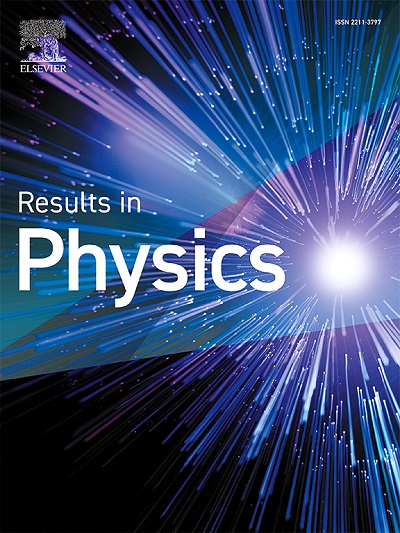First-principles investigation of CaV2TeO8: a multifunctional heteroanionic oxychalcogenide for photocatalytic and thermoelectric applications
IF 4.4
2区 物理与天体物理
Q2 MATERIALS SCIENCE, MULTIDISCIPLINARY
引用次数: 0
Abstract
The development of industrial growth raises global energy demand. Novel materials with promising unorthodox features satiate and demand for sustainable, nontoxic, and cost-effective energy resources. In prospect to that, a first principles investigation was carried out to calculate the ground state and transport properties of CaV2TeO8 for thermoelectric and photocatalytic applications. In this investigation, CaV2TeO8 was mechanically stable at 1194.683 Å3 with a large elastic modulus of 117.95 GPa in the equilibrium state. To understand the electronic properties of CaV2TeO8 PBE-GGA exchange correlation was used to demonstrate the direct and indirect transition of a wide bandgap of 2.7–2.8 eV semiconducting nature. The optical properties of CaV2TeO8 include visible and UV absorption rage with energy of 2.8 eV. Further, to understand the properties of photogenerated charge carriers, the deformation potential theory was used to estimate the mobility of the charge carrier, Excitonic radius, and effective mass. Axial anisotropic strain in band degeneracy and shift in S-Y and Y- transition offers 3.17 Å of Frenkel type strongly bound exciton with a high carrier mobility of 2409.91 cm2 V−1 s−1 electrons and 316.46 cm2 V−1 s−1 holes, respectively. To estimate the feasibility of CaV2TeO8 in photocatalysis through the conduction and valence band edge under harsh pH conditions and various exchange correlations. The band edges of CaV2TeO8 show a halfway reaction of hydrogen evolution with reference to the Normal Hydrogen Electrode (NHE). The Boltzmann equation interface was also used to investigate the transport and thermoelectric properties. The results of the present study show a high Seebeck coefficient in CaV2TeO8 at 300 K and direct a thermoelectric figure of merit of 0.91. The high figure of merit and Seebeck coefficient at 300 K demonstrates CaV2TeO8 may suitable to flexible waste heat recovery system.
用于光催化和热电应用的多功能异阴离子氧硫族化合物CaV2TeO8的第一性原理研究
工业增长的发展提高了全球能源需求。新型材料具有独特的特性,满足了人们对可持续、无毒、高性价比能源的需求。为此,我们进行了第一性原理研究,计算了热电和光催化应用的CaV2TeO8的基态和输运性质。在本研究中,CaV2TeO8的力学稳定性为1194.683 Å3,平衡状态下的弹性模量为117.95 GPa。为了了解CaV2TeO8的电子性质,利用PBE-GGA交换相关证明了其直接和间接跃迁为2.7-2.8 eV宽带隙的半导体性质。CaV2TeO8的光学性质包括可见光和紫外吸收范围,能量为2.8 eV。此外,为了了解光生载流子的性质,利用变形势理论估计了载流子的迁移率、激子半径和有效质量。s -Y和Y-Γ跃迁中的轴向各向异性应变提供了3.17 Å的Frenkel型强束缚激子,载流子迁移率分别为2409.91 cm2 V−1 s−1电子和316.46 cm2 V−1 s−1空穴。在恶劣的pH条件和各种交换相关性下,通过电导和价带边来评估CaV2TeO8光催化的可行性。与正常氢电极(NHE)相比,CaV2TeO8的能带边缘表现为半析氢反应。玻尔兹曼方程界面也用于研究输运和热电性质。本研究结果表明,在300 K时,CaV2TeO8的塞贝克系数很高,热电系数为0.91。300 K时的高品质系数和塞贝克系数表明,CaV2TeO8适用于柔性余热回收系统。
本文章由计算机程序翻译,如有差异,请以英文原文为准。
求助全文
约1分钟内获得全文
求助全文
来源期刊

Results in Physics
MATERIALS SCIENCE, MULTIDISCIPLINARYPHYSIC-PHYSICS, MULTIDISCIPLINARY
CiteScore
8.70
自引率
9.40%
发文量
754
审稿时长
50 days
期刊介绍:
Results in Physics is an open access journal offering authors the opportunity to publish in all fundamental and interdisciplinary areas of physics, materials science, and applied physics. Papers of a theoretical, computational, and experimental nature are all welcome. Results in Physics accepts papers that are scientifically sound, technically correct and provide valuable new knowledge to the physics community. Topics such as three-dimensional flow and magnetohydrodynamics are not within the scope of Results in Physics.
Results in Physics welcomes three types of papers:
1. Full research papers
2. Microarticles: very short papers, no longer than two pages. They may consist of a single, but well-described piece of information, such as:
- Data and/or a plot plus a description
- Description of a new method or instrumentation
- Negative results
- Concept or design study
3. Letters to the Editor: Letters discussing a recent article published in Results in Physics are welcome. These are objective, constructive, or educational critiques of papers published in Results in Physics. Accepted letters will be sent to the author of the original paper for a response. Each letter and response is published together. Letters should be received within 8 weeks of the article''s publication. They should not exceed 750 words of text and 10 references.
 求助内容:
求助内容: 应助结果提醒方式:
应助结果提醒方式:


